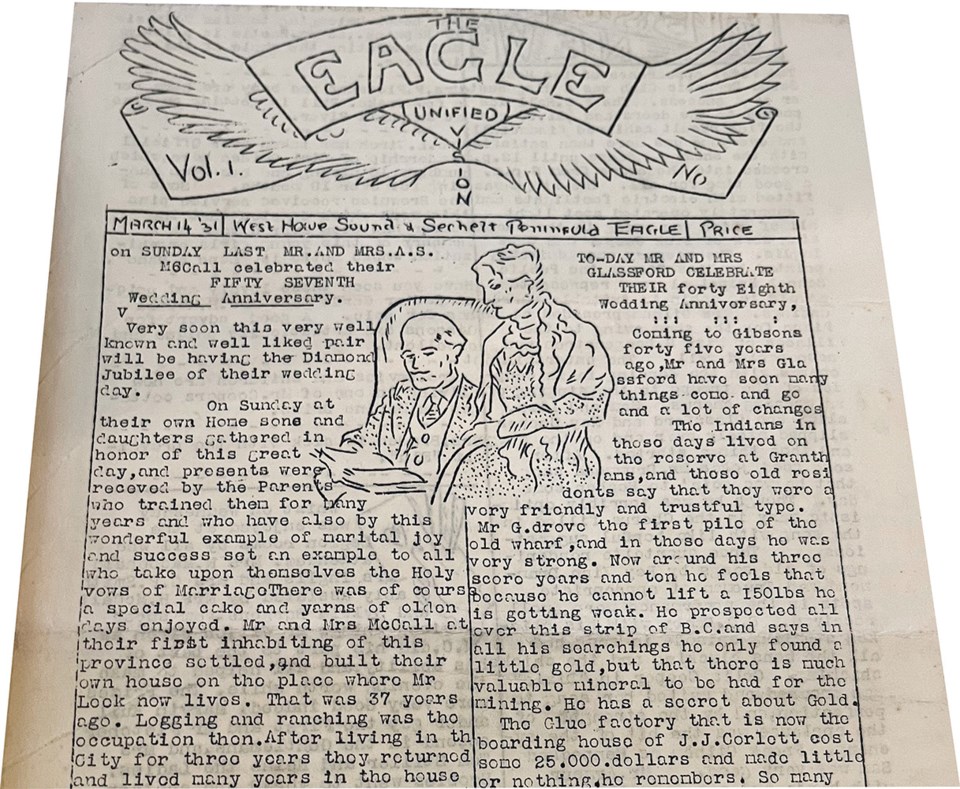The year 2025 heralds the 95th anniversary of newspapers on the southern Sunshine Coast.
The earliest printed news serial on the Coast was a typewritten bulletin mimeographed on foolscap paper.
Its publisher was the Reverend Cyril Owen Darby, who in 1928 restored the derelict St. Bartholomew’s Church. He led Anglican services there and at other locations around the Coast.
The church was originally built in 1892 on property owned by William Manning, at the top of the steep hill above Gibson’s Landing. By the turn of the century, the steepled structure was abandoned and over the next two decades it became dilapidated. After settling in Gibsons in 1929, Darby led efforts to repair and expand the sanctuary.
In 1930 the energetic Darby (also a devoted Girl Guides leader) launched the West Howe Sound and Sechelt Peninsula Eagle. The publication included anniversary announcements, accounts of community meetings, and advertisements for enterprises such as the Elphinstone Co-op Store and car repairs offered by the Klein Brothers of Roberts Creek. Hand-drawn sketches appeared alongside the typewritten text. It cost a nickel to purchase a copy.
By the Eagle’s final issues of 1932, Darby was using the modest paper’s uniqueness as a branding ploy, claiming status beyond that of a parish leaflet. “The Eagle,” its masthead proclaimed in capital letters, “[is the] only newspaper from Pender Harbour to Port Mellon.” In an editorial note later in the same issue, Darby’s swagger switched to droll modesty: “Thank you for the past support of this little rag, I hope you find it of some use even if only for the fire.”
Gibsons merchant Frank Wyngaert gave Darby the tongue-in-cheek nickname “C.O.D.” because of the parson’s regularly-overdue accounts. Wyngaert got the last laugh when the Eagle folded: he bought Darby’s mimeograph machine.
The next newspaper to appear on the Coast was even more short-lived. On March 1, 1939, a husband-and-wife team headquartered near the Roberts Creek wharf distributed the first issue of The Peninsula Independent. The six-page broadsheet was printed every second Wednesday and circulated as far as Pender Harbour.
The young couple were Irish immigrants. Kathleen O’Neill served as editor; her husband Terence filled the role of associate editor. To make ends meet, Terence laboured with the B & K Logging Company at its Roberts Creek operation.
The Peninsula Independent closed after only three months.
Coincidentally, it was also in 1939 that four boys aged 11 and 12 from Halfmoon Bay produced a community paper they dubbed Red, White and Blue. Their circulation numbers more than quadrupled from the start to the end of their venture: first issue, 7 papers; second issue, 21 papers; third issue, 29 papers; final issue, 31 papers.
No copies of the four-page ditto-press publication exist today. What’s certain is that the four boys — Gordon Head, Don King, Oli Johansen and Teddy Osborne — were motivated by a sense of civic responsibility at the start of the Second World War.
Their paper promoted War Savings Stamps, a scheme by which Canadian children raised money for the war effort. A stamp could be purchased from the local post office for 25 cents and affixed to a government-supplied booklet (printed in the colours that inspired the newspaper’s name). A page filled with 16 stamps (a $4 value) was redeemable for $5 after the war.
Whether the four chums redeemed their booklets at the war’s end is unknown. By 1945, Head was attending classes in Mission City and the others were enrolled in Vancouver schools. Their early journalism in Halfmoon Bay must have seemed like a distant memory, a halcyon boyhood when their headlines conjectured that Tommy Beasley might raise the cost of ice cream and pop at his gas station to pay for a new car.
They would probably have been surprised to see their project credited as a pioneering precedent by the longest-lived newspaper on the Sunshine Coast. The Coast News published its first weekly issue on July 11, 1945, also from headquarters in Halfmoon Bay. Its inaugural issue recalled the earnest efforts of the boys of Red, White and Blue.
The Coast News would ultimately run its course in 1995, outlasting a dozen other titles over its 50-year lifespan. Certain staff members founded The Independent, whose union with the upstart Reporter six years later formed the Coast Reporter on the auspicious date of April 1.
An ongoing research project by the Coast Reporter’s culture department has documented details of the nearly 30 newspapers once active on the Coast. It all began nearly a century ago, when a gossipy rag called The Eagle took flight.
Explore dates and details of Sunshine Coast serials at michaelgurney.com/culture.





